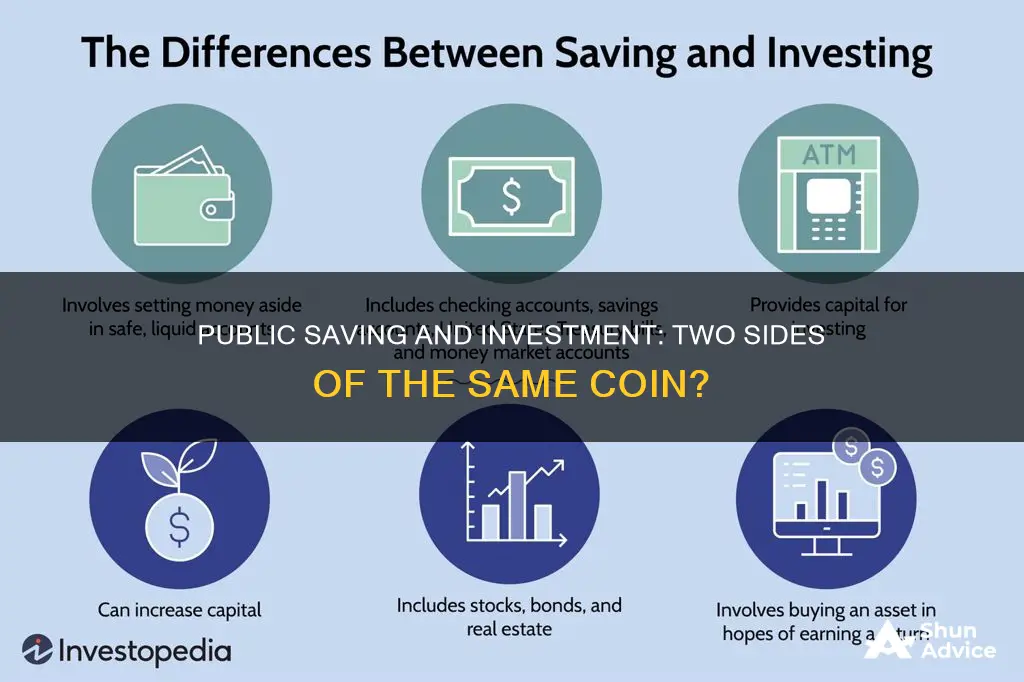
The saving-investment identity is a concept in national income accounting that states that the amount saved in an economy will be the amount invested in new physical machinery, inventories, and the like. In other words, the flow variable investment must be financed by a combination of private domestic saving, government saving (surplus), and foreign saving (foreign capital inflows). This is true by definition, as investment includes inventory accumulation, both deliberate and unintended.
In a closed economy with a government, the remainder of aggregate output (Y), after subtracting consumption by individuals (C) and the government (G), must equal investment (I). This can be expressed as:
{\displaystyle Y=C+I+G}
{\displaystyle \to I=Y-C-G}
This means that national income (Y) minus consumption (C) and government spending (G) is equal to investment (I).
In an open economy, a similar expression can be derived. The national income identity is:
{\displaystyle Y=C+I+G+(X-M)}
where (X-M) is the balance of trade (exports minus imports). Private saving (S) is calculated as:
{\displaystyle S=Y-T-C}
where T is the amount of taxes levied. Combining these expressions and solving for Y-C gives:
{\displaystyle I+G+(X-M)=S+T\to I=S+(T-G)+(M-X)}
Here, I is total investment, S is private saving, T is taxes, G is government spending, M is imports, and X is exports.
Therefore, in both closed and open economies, investment is equal to savings. However, it is important to note that this does not imply that an increase in saving will directly lead to an increase in investment. Businesses may respond to increased inventories by decreasing output and intended investment, which would lead to a reduction in income and, consequently, an unintended reduction in saving.
What You'll Learn
- Public saving is positive when there is a budget surplus
- The saving-investment identity is true by definition
- The saving-investment identity holds true because saving is defined to include private saving
- A trade surplus means that domestic financial capital is in surplus
- The fundamental notion is that the total quantity of financial capital demanded equals the total supplied

Public saving is positive when there is a budget surplus
The budget surplus is calculated by subtracting government spending from tax revenue. In other words, it is the amount of money left over when tax revenue is greater than government spending. This can occur when taxes are increased, government spending is reduced, or the economy is performing well and tax revenues increase as a result.
A budget surplus can have several effects on the economy. Firstly, it can lead to a reduction in public debt, as the government uses the surplus funds to pay off its debts. This can improve the country's credit rating and reduce the cost of borrowing for the government and businesses within the country.
Secondly, a budget surplus can be used to increase investment in public services and infrastructure, which can have positive effects on the economy in the long term. For example, investing in education can lead to a more skilled workforce, while investing in transportation infrastructure can improve efficiency and reduce costs for businesses.
Additionally, a budget surplus can be used to reduce taxes, which can put more money back into the hands of consumers, potentially increasing consumption and economic growth.
However, it is important to note that a budget surplus can also have negative effects if it is the result of reduced government spending on important areas such as education, healthcare, or social services. It is crucial to balance the need for fiscal responsibility with investments in areas that are crucial for the long-term well-being of the country and its citizens.
Invest Wisely for Your Grandchild's Future: A Guide
You may want to see also

The saving-investment identity is true by definition
The saving-investment identity is a concept in national income accounting. It states that the amount saved in an economy will be the amount invested in new physical machinery, inventories, and similar assets. This is true by definition because investment is defined as including inventory accumulation, both deliberate and unintended.
In an open economy, private saving, government saving (budget surplus), and foreign saving (capital inflows) must equal private physical investment. This means that the flow variable investment is financed by a combination of private domestic saving, government saving, and foreign saving.
The saving-investment identity holds true because saving is defined to include both private and public saving. Public saving is positive when there is a budget surplus, i.e., when there is public debt reduction. Therefore, in an open economy, private saving plus government saving (surplus) plus foreign investment domestically (capital inflows) must equal private physical investment.
The saving-investment identity can be expressed in algebraic terms as:
Supply of financial capital = Demand for financial capital
S + (M - X) = I + (G - T)
Where:
- S is private savings
- T is taxes
- G is government spending
- M is imports
- X is exports
- I is investment
This relationship is true as a matter of definition because, in a macro economy, the quantity of financial capital supplied must be equal to the quantity demanded.
The saving-investment identity is a useful framework for understanding the determinants of the trade and current account balance. It shows that a nation's balance of trade is determined by its own levels of domestic saving and investment. By rearranging the identity, we can see that a trade deficit is equal to domestic investment minus private and public savings. Conversely, a trade surplus is equal to private and public savings minus domestic investment.
In summary, the saving-investment identity is true by definition because it is based on the fundamental notion that the total quantity of financial capital demanded equals the total quantity of financial capital supplied. This relationship holds true in both closed and open economies, and it provides valuable insights into the dynamics of trade balances and international capital flows.
Social Security Investment Strategies: Maximizing Your Savings
You may want to see also

The saving-investment identity holds true because saving is defined to include private saving
The saving-investment identity is a concept in national income accounting. It states that the amount saved in an economy will be the amount invested in new physical machinery, new inventories, and similar assets. This is an "identity", meaning it is true by definition.
In a closed economy with a government, the remainder of aggregate output (Y), after subtracting consumption by individuals (C) and the government (G), must equal investment (I). This can be expressed as:
{\displaystyle Y=C+I+G}
{\displaystyle \to I=Y-C-G}
It is also true that:
{\displaystyle Y=C+S+T}
{\displaystyle \to S=Y-T-C}
Where T is the amount of taxes levied. This equation says that saving (S) is equal to disposable income (Y-T) minus consumption (C). Combining both expressions gives:
{\displaystyle I+G=S+T}
{\displaystyle \to I=\underbrace {S} _{\text {private saving}}}+\underbrace { (T-G) } _{\text {public saving}}}
Thus, investment is equal to private saving plus public saving.
In an open economy, a similar expression can be derived. The national income identity is:
{\displaystyle Y=C+I+G+(X-M)}
Where (X-M) is the balance of trade (exports minus imports). Private saving is still {\displaystyle S=Y-T-C}, so combining both expressions gives:
{\displaystyle I+G+(X-M)=S+T\to I=\underbrace {S} _{\text{private saving}}+\underbrace { (T-G) } _{\text {public saving}}+\underbrace {(M-X) } _{\text capital inflow}}
Thus, in an open economy, investment is equal to private saving, plus public saving, plus capital inflow.
Smart Ways to Invest Your RBFCU Savings
You may want to see also

A trade surplus means that domestic financial capital is in surplus
A trade surplus occurs when a country's exports exceed its imports, creating a positive balance of trade. This represents a net inflow of domestic currency from foreign markets.
In the context of the national saving and investment identity, a trade surplus indicates that a country's domestic financial capital is higher than its domestic investment. This excess financial capital can then be invested in other countries.
The national saving and investment identity equation is as follows:
> Domestic investment – Private domestic saving – Government (or public) savings = Trade balance
In the case of a trade surplus, the equation can be rearranged as:
> Private domestic saving + Public saving – Domestic investment = Trade surplus
This equation demonstrates that in a trade surplus, domestic savings (both private and public) exceed domestic investment, resulting in excess financial capital that can be invested abroad.
It's important to note that the fundamental principle of the national saving and investment identity is that the total quantity of financial capital demanded must equal the total quantity supplied. While the government and trade balance components can fluctuate between the supply and demand sides of the equation, domestic savings will always be part of the supply of financial capital, and domestic investment will always be part of the demand.
Therefore, a trade surplus indicates a surplus of domestic financial capital available for investment in other countries, contributing to the outflow of financial capital associated with a positive trade balance.
Invest Your Savings Wisely: The Power of ETFs
You may want to see also

The fundamental notion is that the total quantity of financial capital demanded equals the total supplied
The fundamental notion that the total quantity of financial capital demanded equals the total supplied is a basic tenet of macroeconomics. This concept is known as the "national saving and investment identity" or the "saving-investment identity".
In a closed economy with government, the saving-investment identity can be expressed as:
> Y = C + I + G
>
> I = Y - C - G
Here, Y represents the remainder of aggregate output, C is consumption by individuals, I is investment, and G is government consumption.
In an open economy, the national income identity includes foreign trade and capital flows:
> Y = C + I + G + (X - M)
Where X represents exports and M represents imports.
The saving-investment identity holds true because investment is defined to include both deliberate and unintended inventory accumulation. For example, if consumers decide to save more and spend less, the resulting fall in demand would lead to an increase in business inventories, bringing saving and investment into balance.
The national saving and investment identity can be derived from the national income identity:
> Y - C - G = I + (X - M)
>
> (Y - T - C) + (T - G) = I + (X - M)
>
> S + (T - G) = I + (X - M)
Here, T represents tax revenue, and S is private savings.
This equation shows that the quantity supplied of financial capital (left-hand side) is equal to the quantity demanded (right-hand side).
In an economy, there are two main sources of financial capital: private savings and public savings. Public savings can be negative, indicating a budget deficit where the government spends more than it receives in taxes. In such cases, the government becomes a demander of financial capital, and the national saving and investment identity can be rewritten as:
> S + (M - X) = I + (G - T)
This equation illustrates that a change in any part of the identity must be accompanied by offsetting changes elsewhere to maintain the equality of quantity supplied and demanded.
The national saving and investment identity always holds true, but its formula may vary depending on whether the government has a budget surplus or deficit and the balance of trade. For instance, during a budget surplus, the government acts as a saver, and the identity can be written as:
> S + (M - X) + (T - G)
While during a budget deficit, the government becomes a borrower, and the identity becomes:
> I + (X - M) + (G - T)
In summary, the total quantity of financial capital demanded equals the total supplied, as expressed by the national saving and investment identity. This identity considers both private and public savings, investment, government spending, trade balances, and tax revenues. The specific formula may vary depending on the economic conditions, but the underlying principle remains: the quantity supplied of financial capital must equal the quantity demanded.
S-Corp Savings: Investing for Growth and Security
You may want to see also
Frequently asked questions
In a closed economy, national saving is the sum of private and public saving. It equals a nation's income minus consumption and government spending. Therefore, the amount saved in an economy will be the amount invested in new physical machinery, new inventories, and the like.
The saving-investment identity is a concept in national income accounting stating that the amount saved in an economy will be the amount invested. This identity only holds true because investment here is defined as including inventory accumulation, both deliberate and unintended.
Savings refers to the amount of money that is not spent by consumers, while investment includes the purchase of new physical machinery, inventories, and other capital expenditures.
The national saving and investment identity can be expressed as:
[latex]\begin{array}{rcl}\text{Supply of financial capital}& \text{ = }& \text{Demand for financial capital} \\ \text{S + (M - X)}& \text{ = }& \text{I + (G - T)}\end{array} [latex]
Where S is private savings, T is taxes, G is government spending, M is imports, X is exports, and I is investment. The government budget can be in surplus (G - T > 0) or deficit (G - T < 0), affecting whether the government appears on the supply or demand side of the equation.







